
Psoriasis is a pathology in which the human immune system mistakenly attacks healthy skin cells. As a result, plaques appear on its surface, which can be very itchy and even painful. Sometimes the disease is accompanied by inflammation of the joints and eyes.
What is psoriasis
Psoriasis is a chronic autoimmune disease that causes red, scaly patches to appear on the surface of the skin. Often called plaques.
Psoriasis is not contagious - it is an autoimmune, non-infectious disease.
Psoriasis manifests itself in the inflammation of the skin, as well as in the abnormally rapid growth and peeling of the cells (keratinocytes) that make up the stratum corneum - the epithelial layer. Usually, it is completely renewed within a month, but in psoriasis this process is accelerated many times over and takes place in an average of 3-4 days.
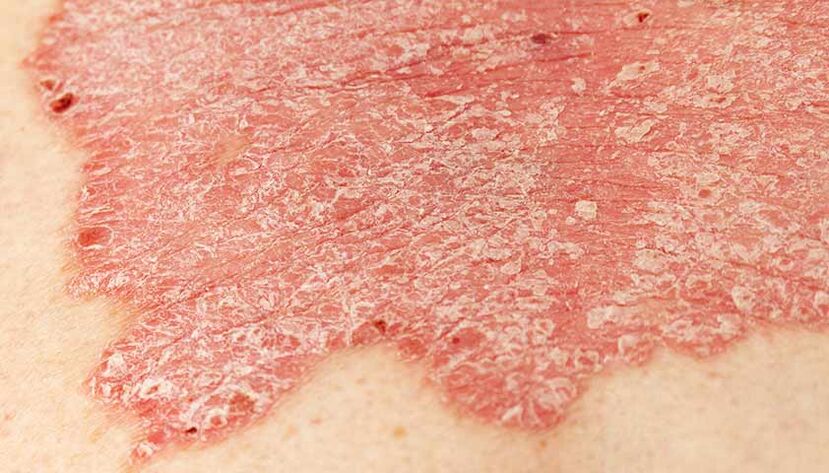
In addition to skin damage, the disease also causes arthritis (in about 30% of cases). A little less often - in 10% of cases - psoriasis leads to inflammation of the uvea (uveitis).
The prevalence of psoriasis
Psoriasis most often affects the 15-35 age group, but it can usually occur at any age. The first peak of the appearance of the pathology occurs at the age of 15-20, and the second at the age of 55-60.
Psoriasis affects an average of 1-2% of people worldwide. According to the clinical recommendations of the Ministry of Health in Hungary, the prevalence of the disease in 2021 was 243. 7 cases/100, 000 inhabitants.
Types of psoriasis
Like many chronic diseases, psoriasis can be distinguished by its stages, severity and form of manifestation.
By stage
Psoriasis has three stages: progressive, stationary and regressive stage (remission).
TENDONprogressive stagered spots appear on the skin. They coalesce to form large, scaly plaques with marked red outlines around the edges - this is called erythematous erythema. Redness of the skin caused by the dilation of capillaries and blood flow. corolla, or corolla. New plaques can be very itchy and painful.
Traumatic areas of the skin are particularly sensitive to the appearance of new spots: psoriatic plaques can quickly form in places of friction (for example, on clothing) and in the area of scratching or scratching. Doctors call this phenomenon the Koebner phenomenon.
This phenomenon, also known as the "isomorphic reaction", was discovered by the German dermatologist Heinrich Koebner in 1872. Doctors have noticed that some patients with psoriasis develop new plaques on the skin at the site of injury, such as after scratches, injections or bruises.
Standing stage- stabilization phase. The growth of plaques stops, but they continue to bother and peel off. New rashes and spots usually do not appear.
Regression stageoccurs when the symptoms of psoriasis begin to disappear. The peeling goes away, the plaques lighten and flatten. During this stage, the symptoms decrease.
By severity
To assess the severity of psoriasis, doctors use the Psoriasis Area and Severity Index (PASI) system - an index for assessing the severity and prevalence of psoriasis. It requires professional analysis of parameters such as severity of erythema, infiltration, desquamation, and calculation of skin area affected by rashes.
Based on the test results, doctors distinguish between mild, moderate and severe degrees of the disease.
According to form
Based on the clinical picture of the manifestations, several main forms of psoriasis can be distinguished: vulgar, inverse, seborrheic, exudative, guttate, pustular, palmar and plantar psoriasis and psoriatic erythroderma.
Vulgar (ordinary) psoriasis- one of the most common forms, accounting for about 90% of all cases of the disease. First, red spots appear on the skin, which turn into raised, scaly plaques within a few days. As the plaques develop, they coalesce into large, itchy, scaly lesions. Then the condition enters the stage of stabilization and regression: the manifestations of the disease temporarily recede and the person's well-being improves.
The most common site of psoriasis vulgaris is the extensor (external) part of the skin of the elbows and knees. The changes appear on the body and scalp.
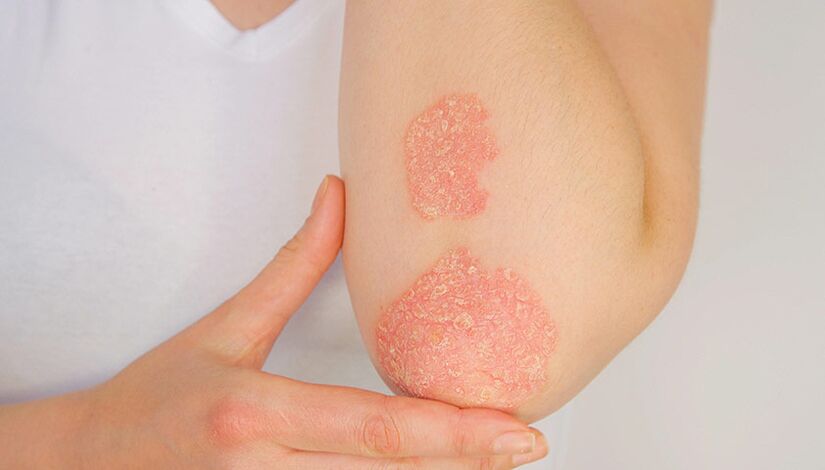
Psoriasis vulgaris on the outside of the elbow
Inverse ("reversed") psoriasisis done in the usual way. The only difference is in the location of the lesions: they appear not in the extensor (outer) part of the knee and elbow, but in the flexor (inner) part - that is, under the knee, under the armpit and in the elbow. area, as well as in the neck, eyelids, navel, inguinal folds. The skin in these places is more sensitive, moist and rubs against clothes more often. Because of this, it may itch more than with the usual form of the disease, but the peeling in these places is less pronounced.
Seborrheic psoriasisit progresses in the same way as normal, but its foci are located in places where there are a large number of sebaceous glands. This is the scalp, folds behind the ears, cheeks and nasolabial part of the face, forehead, chest and back (especially the upper part).
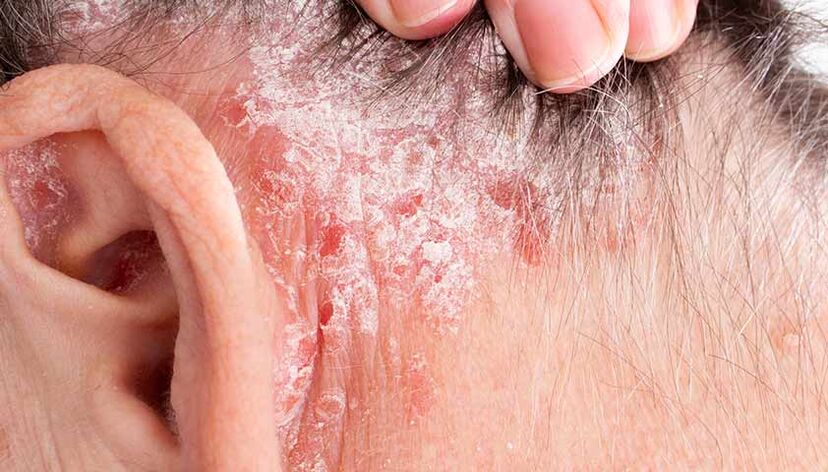
Seborrhoeic psoriasis on the scalp
Exudative psoriasis- a type of disease in which, in addition to peeling, exudate also appears in the lesion. It is a fluid containing protein, certain blood cells, and other substances. During inflammation, exudate can be released from the capillaries.
The crust on the surface of the plaques in the exudative form of the disease is usually dense, grayish-yellow, sometimes slightly moist. This type of psoriasis most often occurs in people suffering from endocrine diseases: thyroid pathologies, type 2 diabetes or obesity.
Guttate psoriasisIt does not appear on the skin as plaques, but as numerous papules - bright red, swollen spots with peeling in the middle. The papules can vary in size from about 1 to 10 mm. They mainly cover the torso, arms and legs.
Guttate psoriasis usually occurs in children after streptococcal infections (such as tonsillitis). It is treated somewhat better than other types of psoriasis, but in some cases it can turn into the usual (vulgar) form.
Pustular psoriasisit is characterized by the appearance of several pustules on a red erythematous base. Pustules are formations that are very similar to acne. Such psoriasis can be caused by infectious diseases, stress, hormonal imbalance, improper use of medication or improper use of ointments. Initially, numerous pustules appear on the red spots. They then merge into a large pus patch (or "pus pool").
The generalized form of pustular psoriasis is difficult to tolerate: with episodes of fever, weakness, and severe pain and burning. At the same time, changes in the nails and joint pain can be observed.
Psoriasis of the palms and soles- typical psoriatic rashes appear on the palms and soles, less commonly in the form of localized pustular psoriasis. It can also affect and deform the nails – they become thicker, cloudy and uneven.
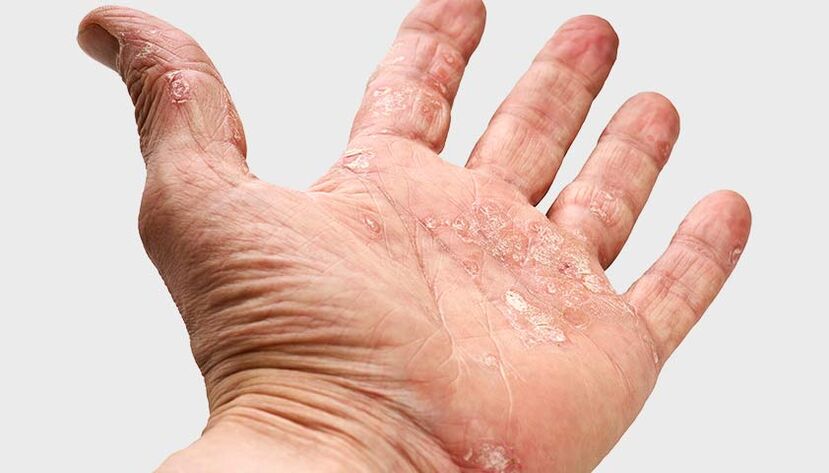
Psoriasis on the palm
Erythrodermic psoriasisIt is quite rare and is considered an extremely severe form of the disease. Approximately 90% of the body becomes red, severe itching and pain occur, the skin swells and peels. The temperature often rises and the lymph nodes become inflamed.
This type of psoriasis is typically the result of an aggravation of another form of the disease due to inadequate treatment or adverse environmental factors (e. g. , in advanced psoriasis vulgaris, sunburn, inappropriate use of irritating external agents, or intravenous administration of glucocorticosteroids).
Symptoms of psoriasis
The manifestations of psoriasis vary depending on the type and severity of the disease.
Common symptoms and signs of psoriasis:
- red, raised, scaly patches on the skin;
- itching in the area of inflammation and peeling;
- changes in the nails: precise impressions, thickening and crumbling of the plate, separation;
- joint pain (sometimes).
For an accurate diagnosis, you should consult a specialist - a dermatologist.
The mechanism of psoriasis formation
Psoriasis is an autoimmune disease.
All autoimmune pathologies are associated with a malfunction of the immune system. It usually "scans" the body day and night, looking for pathogenic cells with the help of foreign protein molecules that distinguish them from the "normal" cells inherent in the body.
As soon as it detects foreign protein molecules, the immune system activates special immune cells - T lymphocytes - which must destroy the enemy.
However, in some people, the friend-foe recognition system may break down. As a result, the immune system begins to attack the healthy cells of individual organs or tissues, causing inflammation in their place and harming your body in every possible way, which it is actually supposed to protect.
This is what happens with psoriasis: the immune system attacks the skin. It activates T-lymphocytes and "inserts" them onto the skin cells. After reaching the target, the T-lymphocytes release inflammatory substances - cytokines. They trigger the first symptoms: skin redness, swelling, itching and pain.
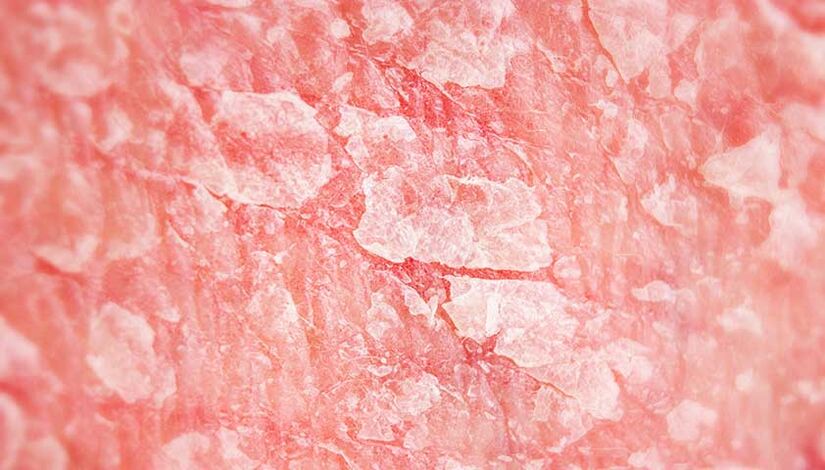
With psoriasis, skin cells divide several times faster, resulting in psoriasis and peeling.
Under the influence of cytokines, an inflammatory process develops and skin cells begin to divide actively - this is how active exfoliation occurs and a raised plaque is formed.
Since the cell renewal process accelerates almost tenfold, the main cells of the epidermis (keratinocytes) do not have time to develop properly. Therefore, they cannot perform their barrier function.
As a result, the stratum corneum becomes permeable and no longer protects the deeper layers of the skin from the environment and moisture loss. All of this leads to more inflammation.
Until the immune system calms down, the disease progresses and symptoms worsen.
Causes of psoriasis
The exact causes of psoriasis are not yet fully understood. However, many studies agree that the development of psoriasis is linked to genetics, lifestyle, co-morbidities and adverse environmental factors.
Genetics
Children often inherit the disease from parents. Psoriasis is mainly linked to the HLA-C gene. It codes for a protein that allows the immune system to recognize its own (harmless) cells.
In patients with psoriasis, doctors detect a special genetic marker in the HLA-C gene more often than in other people - HLA-Cw6. However, its presence only indicates a predisposition to the disease. Not all people with the HLA-Cw6 marker necessarily have psoriasis, and not all patients diagnosed with the disease have this genetic change.
Lifestyle
It is believed that permanent damage to the skin, frequent friction, sunburn and hypothermia can be the main causes of the development of the disease. Especially if you have a hereditary predisposition in the form of the HLA-Cw6 genetic marker, or if your close relatives suffer from psoriasis.
Other risk factors are constant stress, alcohol consumption and smoking - all of which have a harmful effect on metabolism, the functioning of internal organs and the immune system.
Concomitant pathologies
Some types of psoriasis, such as guttate psoriasis, can occur after a streptococcal infection.
In addition, the risk of developing pathology increases in people with autoimmune diseases. Examples include type 1 diabetes, Crohn's disease, systemic lupus erythematosus, and rheumatoid arthritis.
In such diseases, the general mechanism of the immune system is upset: it perceives its own cells as foreign, reacts with inflammation and destroys them. Accordingly, the risk of adding other cells to the "black list" by mistake increases.
Complications of psoriasis
Psoriasis is caused by a malfunction of the immune system and chronic systemic inflammation. It develops due to the constant aggression of immune cells towards healthy tissues.
Autoimmune processes are characterized by the fact that they can spread: the immune system is able to include other healthy cells as "enemies" at any time.
For example, psoriasis can develop into Crohn's disease or ulcerative colitis if the immune system mistakenly attacks the tissues of the gastrointestinal tract.
In addition to autoimmune diseases, people with psoriasis are prone to various endocrine pathologies (metabolic syndrome, obesity, type 2 diabetes), cardiovascular diseases (hypertension, heart attack) and other internal organ dysfunctions. All of this is related to a chronic inflammatory process that affects hormone levels and disrupts normal metabolism.
A special complication is psoriatic arthritis. It occurs in about 30% of people with psoriasis.
In psoriatic arthritis, the immune system attacks the connective tissue, most often affecting the joints of the lower limbs. Inflammation of the joint structures develops, the skin in the affected area may become red, swelling may occur, and pain and/or stiffness may occur when bending or straightening the joint.
In 10% of people with psoriasis, the pathology spreads to the eye and develops uveitis. The choroid of the eye becomes inflamed, causing reduced vision and discomfort.
In addition to physiological complications, psoriasis can affect a person's mental health. Changes in appearance, poor skin condition and unbearable itching can cause a lack of self-confidence and lead to a depressive disorder.
Diagnosis of psoriasis
A dermatologist diagnoses skin conditions, including psoriasis.
During the appointment, the doctor will ask about the symptoms and how long ago they appeared. He then asks his closest relatives: parents, siblings about skin diseases. Family history allows the specialist to immediately assume diseases that can be inherited - psoriasis is one of them.
The doctor will also ask about situations that trigger the appearance of new rashes and worsening symptoms. For example, new psoriatic lesions may appear after a hot bath or prolonged exposure to the sun. In some patients, plaques appear at the injection site, on scratches, or after rubbing the skin with clothing - this is how the Koebner phenomenon, characteristic of psoriasis, manifests itself.
An important point in establishing the diagnosis is the examination of the rashes. If the picture of the disease is not appropriate, the specialist can observe the rash over time and prescribe a histological examination of the skin (biopsy).
If the doctor is not sure that the plaques on the skin are psoriasis, a biopsy and a histological examination of the skin are prescribed.
Histological examination of skin and subcutaneous tumors
The test allows us to identify malignant changes in the tissues of skin tumors (birthmarks, papillomas, warts, age spots). Material obtained by biopsy or during surgery is used for the analysis.
In some cases, a specialist can check the triad of psoriasis, the main diagnostic signs of psoriasis.
First, the dermatologist takes a slide or scalpel and gently scrapes the surface of the plaque. The first sign of the triad is the slight exfoliation of whitish scales on its surface, or the stearin spot phenomenon.
After peeling off all scabs, the surface of the plaque will be smooth, shiny and slightly moist. This is the second sign of the triad - terminal film.
If the doctor continues to scratch the spot, bleeding will appear exactly on its surface, which is called Auspitz syndrome, or bloody dew, the third sign of the psoriasis triad.
After the examination and anamnesis, the doctor prescribes laboratory tests. A clinical blood test is usually recommended - it reflects your general health. The patient is also referred for blood biochemistry. It allows the evaluation of the functioning of the internal organs and the metabolism - in case of a long course, psoriasis can provoke pathologies of the cardiovascular system and the endocrine system.
A general urinalysis is also often prescribed. Disorders related to the urinary system can interfere with the prescription of certain medications.
The general urinalysis includes a physical and chemical examination of the urine (color, density, composition) and a microscopic examination of its sediment. A general urinalysis is prescribed to check the condition of the body, to identify pathologies of the urinary system, gastrointestinal tract, endocrine, infectious and inflammatory diseases.
For the same reason, HIV and hepatitis tests are prescribed according to clinical recommendations. Against the background of these infections, the disease can be more serious.
In addition, in preparation for treatment, women should take a pregnancy test - for example, a blood test for beta-hCG. The fact is that many systemic drugs, which are most often prescribed for the treatment of psoriasis and have a good effect, are contraindicated during pregnancy.
The test allows early diagnosis of pregnancy and identification of complications. In the case of induced abortion, it is used to evaluate the effectiveness of the procedure. In oncology - to diagnose hormone-producing tumors.
If you complain of joint pain, your doctor may also refer you to an MRI, CT scan, or X-ray to confirm or rule out psoriatic arthritis. If arthritis is confirmed, the dermatologist recommends a rheumatologist's examination.
Treatment of psoriasis
If the affected area of skin is small, patients are prescribed topical corticosteroid creams or ointments. They suppress inflammation and reduce the manifestations of the disease.
In addition, the doctor may prescribe topical analogues of vitamin A or vitamin D. Such drugs relieve inflammation, accelerate the exfoliation of the skin's stratum corneum, and slow down the growth of psoriasis plaques. We also recommend using skin moisturizers from pharmacy dermatocosmetic product lines.
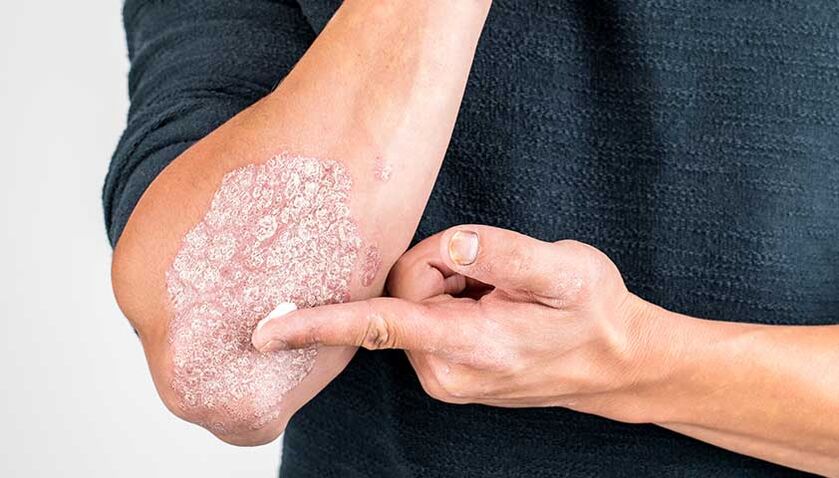
Mild psoriasis is often treated with topical ointments and creams.
In moderate and severe psoriasis, systemic treatment may be necessary - classic immunosuppressive and genetically modified biological drugs in the form of tablets or subcutaneous injections. They have a pronounced effect, but require a thorough examination before use.
Systemic glucocorticosteroids for psoriasis are contraindicated and can only be prescribed by a doctor in certain (extremely difficult) situations and in hospital settings. Otherwise, such treatment can lead to a significant deterioration of the condition.
Psoriasis is also treated with light therapy: a certain spectrum of ultraviolet light is directed at the plaques. Many physical therapy offices have special lights for this type of treatment.
The most modern and effective way to treat psoriasis is monoclonal antibodies (gene technology biological therapy). These drugs can block certain stages of the inflammatory response, such as certain cytokines, cytokines. Proteins, produced mainly by the immune system's protective cells, trigger inflammation and plaque growth in psoriasis.
Psoriasis prevention
There is no specific prevention that can prevent the development of psoriasis.
In general, it is recommended to lead a healthy lifestyle: avoiding alcohol and smoking, exercising, and eating a healthy and balanced diet.
Those whose relatives suffer from psoriasis should take extra care of their skin: moisturize regularly, avoid hypothermia, prolonged exposure to the sun, and avoid visiting the solarium. Tattoos are not recommended if you have a hereditary tendency to psoriasis.
Forecast
Psoriasis is a chronic pathology, like all autoimmune diseases. A complete cure for psoriasis is impossible.
However, timely and properly selected treatment allows the patient to achieve long-term remission - a symptom-free period of the disease.
Frequently asked questions
How does psoriasis spread?
Psoriasis is not contagious. It's an autoimmune disease - it occurs when a person's immune system malfunctions and mistakenly attacks skin cells. The disease has a hereditary (genetic) tendency, which means that it can be inherited.
How does psoriasis manifest itself?
In most cases of psoriasis, large red, scaly plaques appear on the surface of the skin. They can be very itchy and even painful. Most often, psoriasis patches appear on the elbows, knees, trunk, and scalp.
Which doctor treats psoriasis?
A dermatologist treats psoriasis.
Can people with psoriasis be recruited into the army?
A mild form of psoriasis can be classified as category B - "limited suitability". Conscripts suffering from moderate or severe psoriasis are considered unfit for military service. Each specific case is decided individually during the medical examination.




















